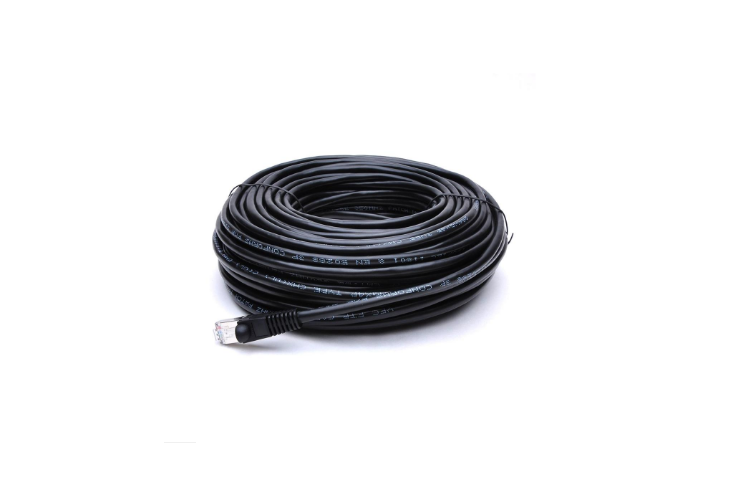Is CAT5 or CAT6 Better for Security Cameras?
The type of cable used is a significant consideration when it comes to a CCTV or IP security camera system. Security cameras in the UK and elsewhere typically connect with Ethernet (network) cables such as CAT5 cable (typically Cat5e) or CAT6 cable.
Both of these support data and power (PoE) to your cameras, but Cat6 cables usually support higher bandwidth and higher resistance to interference than Cat5/Cat5e. That additional performance may enhance reliability and future-proofing - at a somewhat increased cost.

What are CAT5 and CAT6 cables?
CAT5 cable (Category 5):
It is an old standard of Ethernet cable. Cat5 spec was originally intended to support 100 Mbit/s (megabits per second) and 100 MHz bandwidth. Most cables utilized today, under the label of a Cat5, are in fact Cat5e (Category 5e) - a higher quality cable that can support 1 Gbps (gigabyte) over 100 meters and 100 MHz band rates. Cat5e is a 24 AWG copper cable used in simple network systems and is the most typical cable.
CAT6 cable (Category 6):
This is a more recent type of cable with a more demanding standard. Cat6 has increased data rates -10 Gbps over short distances (55 meters) and 1 Gbps up to 100 meters. It operates with heavier 23 AWG wires and closer twists in the pairs, providing it with circa 250 MHz bandwidth.
In the real world, Cat6 has twice the unprotected capacity and higher insulation than Cat5e, which is useful to preserve signal quality in the face of heavy utilization. Cat6 is currently commonly deployed in business networks, particularly where future-proofing or high data transfer is required.
Key Specs (approximate):
Cat5e 1 Gbps, 100 MHz, 100m maximum; Cat6 10 Gbps 55m (100m) / 1 Gbps 100m, 250 MHz.
Why cable type is important to CCTV/IP cameras.
Understanding the type of network cable is important in the performance of the camera. Video (usually HD or 4K) is transmitted over Ethernet by IP cameras, and most are PoE (Power-over-Ethernet) cameras, meaning a single cable is required that transfers data and power.
Higher quality cable ensures that power delivery or data rates are stable without being interrupted or lost. In the case of poor cable construction or inferior Copper-Clad Aluminum (CCA) conductors, voltage drop and signal problems can occur, but when using pure copper cable of the same contact, the integrity and range remain constant.
- Video quality and frame rate: Large data streams are generated by high-resolution cameras (e.g., 4K). Video will be bottlenecked by a cable that is incapable of supporting the bandwidth.
- Reliability: Cables with thicker conductors and shielding (including Cat6) are more resistant to electromagnetic interference (EMI) with adjacent cables or electrical devices. This is especially true in industrial or mixed-use buildings.
- Distance: Ethernet cables all have a practical signal limit (~100 meters). Efficient cable and pure copper can be used to achieve that threshold without lost video frames.
- Future-proofing (also known as future-proof): When today’s cameras use Cat5e, it is possible to easily upgrade to Cat6, without re-cabling, should the user ever need to add additional cameras or increase the resolution of the available ones.
To put it succinctly, the type of cable you use influences the amount of data your cameras can transmit, the cleanliness of the signal, and the distance that the cable can be used without the signal quality being compromised. To the CCTV installers, installing the correct cable implies fewer glitches and a simplified extension in the future.
Comparing CAT5 vs CAT6
Bandwidth:
Cat5e cables can support up to 1 Gbps, sufficient to operate most single IP cameras. Cat6 cables are capable of 10 Gbps (at shorter lengths) and 1 Gbps throughout the entire 100m length.
In practice, this implies that Cat6 provides additional headroom. To illustrate, a single 4K camera (~6080 Mbps) is comfortably within the capabilities of Cat5e; however, when operating multiple cameras off of a single switch or having very high frame rates, Cat6 offers greater bandwidth.
Interference (Crosstalk and EMI):
The twists between wire pairs in cat6 cables are much closer, and a built-in separator may be provided between pairs, dramatically reducing crosstalk (signal bleed between wires). This translates to a cleaner video signal, particularly when in an electrically noisy environment.
Cat5e cables are engineered to slow down crosstalk as well, though Cat6 is more rigid, and shielding can be optional. In case your camera-equipped run is close to motors, fluorescent lights, or other data cables, Cat6 (particularly shielded Cat6) facilitates the preservation of picture quality.
Shielding:
The majority of the cables are UTP (Unshielded Twisted Pair). cat6 cables may be STP (shielded twisted pair) layered. Shielded Cat6 contains metal foil or braids on top of the cores that shield external EMI.
This may be useful in the field or in factories, but shielded cables must be correctly grounded. UTP Cat6 is frequently adequate for typical home/office applications, although shielded Cat6 is also available in case you are aware that there is a problem with interference.
Transmission Distance:
Both Cat5e and Cat6 cables can operate at 1 Gbps to approximately 100 meters (about 328 feet) without attenuation. Beyond approximately 90 to 100 meters, Ethernet signal begins to attenuate unless you introduce repeaters or switches.
The benefit of cat6 is that it can support greater speeds at the same distance, but full 10 Gbps is only assured at a distance of approximately 55 meters. Most CCTV cables, which seldom approach 1 Gbps per link, virtually strike the same 100m limitation.
Durability:
Best Cat6 cables have fatter 23 AWG conductors and tend to have stronger insulation. This gives Cat6 cable physical durability and, in most cases, quality to support commercial/industrial installations. In practice, Cat6 weighs slightly more than Cat5e and is a bit less flexible; however, it is also more resistant to tension or heat.
When you want rough outdoor running (with UV resistant jacketing and waterproofing), outdoor-rated Cat5e or Cat6 is available; Cat6 will generally last longer than Cat5e in extremes.
Pricing:
The Cat6 cables cost more than Cat5e/Cat5. The distinction lies in quality and brand, but bulk Cat6 is usually 10-30 percent more expensive per meter. Other times budget installers can save money using Cat5e when performance is not required.
The higher cost of Cat6 is, however, possibly justified by its additional capacity and future-proofing. Over the last few years, the price difference has become smaller in the UK retail market, so the upgrade to Cat6 is cheaper.
Quick Specs:
Cat5e - max 1 Gbps, 100m, 100 MHz, 24 AWG; Cat6 - max 10 Gbps (55 m)/1 Gbps (100m), 100m, 250 MHz, 23 AWG.
Use-Case Examples
Small Home or Office (Short Runs):
CAT5e (Cat5) is typically acceptable with a few 1080p or even a few 4K cameras with a run under ~50m. It will support gigabit video streams without difficulty, and the majority of home routers/switches have 100 Mbps or 1 Gbps ports anyway. Cat5e is a low-cost option if you are constrained by a tight budget and do not anticipate any upgrades in the near future.
Large Resolution / Lots of Cameras:
CAT6 is more secure in an office, school, or business with dozens of cameras that stream HD/4K. The increased bandwidth will ensure that switches are not congested during times when more than one camera is transmitting data simultaneously.
To use an example, when you are going to install a few 4K cameras (streaming at 3060 FPS), Cat6 can be used to avoid network overload. Also, it is good when installing cameras that are very far apart or in a number of buildings, as Cat6 has been found to achieve good signal quality on long cables.
Long Cable Runs:
When any camera cable exceeds 100 meters in length, the better insulation of Cat6 may provide a clean signal at the end. On the longest runs (without the Ethernet limit), use Cat6 to prevent video dropouts.
Actually, you could upgrade to a fiber-optic connection or Ethernet extender when you have to travel farther than 100m, but under that, Cat6 is strong.
Outdoor/Industrial Sites:
When a camera is needed outside of a factory, foundry, or warehouse, or on the road, consider outdoor-rated Cat6 (typically gel-filled and UV-resistant) or even shielded Cat6. Noise produced by heavy machinery or power lines can be cut by the shield.
Then there is a cable that has a steel messenger wire to mount on the pole. An outdoor-rated Cat5e/Cat6 will withstand moisture and changes in temperature in standard UK conditions; Cat6 versions will have a heavier jacket, which is an advantage.
Takeaway
In short, most modern UK CCTV systems will be fine on Cat5e (Cat5) cable. It enables the use of gigabit speeds and even 100m cables, enough to support the demands of the majority of HD and even 4K IP cameras currently.
Cat5e is also slightly cheaper and can be used in installations with a low budget. But the Cat6 cable has twice the bandwidth (250 MHz spec and 10 Gb limit) and enhanced immunity to noise. The additional performance may be justified when you have a large number of cameras, very high-resolution video, or long cable distances.
Many installers use Cat5e in a typical installation, with Cat6 set aside as needed in higher-demand situations or as a future-proof. When selecting, consider your particular project, the number of cameras needed, how much resolution you need, and the duration of each run.
To illustrate this, CCTV101 documentation states that Cat5e works well with the current IP cameras and that most of the NVRs are 10/100 Mbit switches, indicating that a single camera can hardly surpass 100 Mbps.
Conversely, when you find you want to upgrade to more than one 4K camera or require running the cable in an electrically noisy environment, Cat6 might come in handy in the future.
Key point:
Cat5e cables are more cost-effective than Cat6 cables and offer better performance in bandwidth and signal integrity. Use Cat6 when maximum speed and resistance to interference are required; use Cat5e/Cat5 when cost and standard gigabit are adequate.
FAQ
Can I use CAT5 for 4K security cameras?
Ans: Yes - a Cat5e (1 Gbps) cable should be able to support one 4K camera, as 4K video typically falls below 100 Mbps per stream. Cat5e will not be a bottleneck with one 4K IP camera since most UK IP camera systems and recorders support 1 Gbps or less. But when you have several 4K cameras, or when you need more headroom in the future, consider Cat6.
How far can a CAT6 cable run for CCTV?
Ans: Gigabit speeds to about 100 meters (328 feet). Cat6 (as well as Cat5e) is rated at 100m maximum cable length before the signal deteriorates. Keep in practice, less than 90100m.
Above that, you would have to have an Ethernet extender or a powered switch in the middle of the run. Note that the entire capacity of Cat6 is only assured to be up to ~55m, however, in the case of CCTV work (unless in rare cases 10 Gbps is required), you can assume that 100m will work at 1 Gbps.
Is shielded CAT6 cable worth it for outdoor cameras?
Ans: It is a matter of the environment. Shielded Cat6 (F/FTP or S/FTP) contains an electromagnetic interference shielding metal conductor layer that can help in high-noise environments (around heavy equipment, large motors, or long parallel power leads).
Outdoor-grade unshielded Cat6 (UV-resistant, moisture-resistant jacket) is often adequate in most normal outdoor or residential CCTV applications.
Shielded Cat6 should only be selected when there is substantial EMI or otherwise when additional lightning protection is required. It should be remembered that shielded cables have to be grounded properly in order to be effective.











